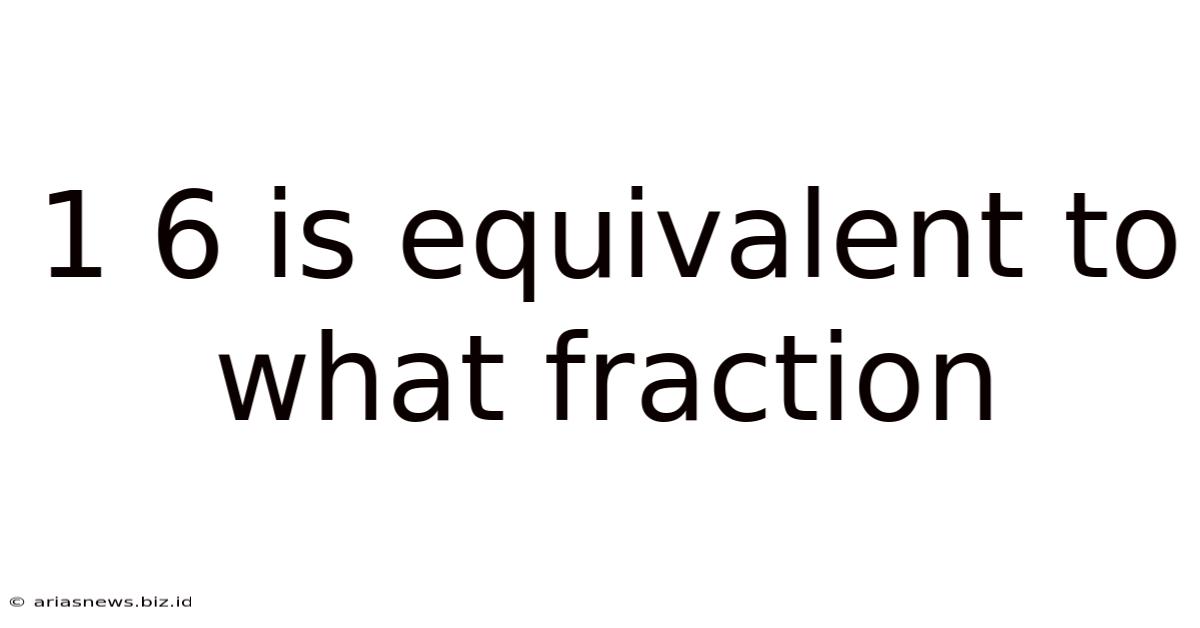1 6 Is Equivalent To What Fraction
Arias News
May 12, 2025 · 5 min read

Table of Contents
1/6 is Equivalent to What Fraction? Exploring Equivalent Fractions and Their Applications
Understanding equivalent fractions is a fundamental concept in mathematics with wide-ranging applications in various fields. This comprehensive guide delves into the meaning of equivalent fractions, explores methods for finding them, and demonstrates their practical uses. We'll specifically address the question: 1/6 is equivalent to what fraction? But we'll go far beyond that single example, providing you with the knowledge and skills to tackle any equivalent fraction problem.
What are Equivalent Fractions?
Equivalent fractions represent the same portion or value, even though they look different. Imagine slicing a pizza: one slice out of six equal slices (1/6) is the same as two slices out of twelve (2/12), or three slices out of eighteen (3/18), and so on. These are all equivalent fractions. They represent the same proportional amount of the whole.
The key to understanding equivalent fractions lies in the relationship between the numerator (the top number) and the denominator (the bottom number). Equivalent fractions are created by multiplying or dividing both the numerator and the denominator by the same non-zero number. This process doesn't change the overall value of the fraction; it simply expresses it in a different form.
Finding Equivalent Fractions: The Fundamental Principle
The fundamental principle of equivalent fractions is:
If you multiply or divide both the numerator and the denominator of a fraction by the same non-zero number, you obtain an equivalent fraction.
Let's illustrate this with the fraction 1/6:
-
Multiplying: If we multiply both the numerator (1) and the denominator (6) by 2, we get 2/12. This is equivalent to 1/6.
-
Multiplying again: Multiplying both by 3 gives 3/18, another equivalent fraction.
-
Multiplying further: Multiplying by 4 yields 4/24, and so on. We can create an infinite number of equivalent fractions by multiplying by any whole number.
-
Simplifying (Dividing): While we can create larger equivalent fractions by multiplying, we can also create smaller ones through division. However, the crucial point here is that the numerator and denominator must both be divisible by the same number without leaving a remainder. In the case of 1/6, this isn't directly possible with whole numbers unless we accept decimals. It is already in its simplest form.
1/6 is Equivalent to What Fraction? Multiple Examples
Now, let's directly address the question: what fractions are equivalent to 1/6? We've already seen a few: 2/12, 3/18, 4/24. Here are a few more, demonstrating the process:
- 1/6 x 5/5 = 5/30 (Multiplying both by 5)
- 1/6 x 6/6 = 6/36 (Multiplying both by 6)
- 1/6 x 10/10 = 10/60 (Multiplying both by 10)
- 1/6 x 100/100 = 100/600 (Multiplying both by 100)
As you can see, the possibilities are endless! Each of these fractions represents the same proportion as 1/6.
Simplifying Fractions: Finding the Simplest Form
While we can generate infinitely many equivalent fractions, it's often useful to find the simplest equivalent fraction. This is the fraction where the numerator and denominator have no common factors other than 1 (meaning they are coprime). This is also known as reducing the fraction to its lowest terms.
In the case of 1/6, the numerator (1) and denominator (6) have no common factors other than 1. Therefore, 1/6 is already in its simplest form. Many of the equivalent fractions listed above (like 2/12, 3/18, etc.) can be simplified back down to 1/6 by dividing both the numerator and the denominator by their greatest common divisor.
Practical Applications of Equivalent Fractions
Understanding equivalent fractions isn't just an academic exercise; it has numerous practical applications:
-
Baking and Cooking: Recipes often require adjusting ingredient quantities. Equivalent fractions allow you to easily convert measurements (e.g., 1/2 cup is equivalent to 2/4 cup or 4/8 cup).
-
Measurement and Engineering: Converting units of measurement, such as inches to feet or centimeters to meters, relies on equivalent fractions. For example, 1/12 of a foot is equivalent to 1 inch.
-
Finance and Budgeting: Equivalent fractions are used in calculating percentages, interest rates, and proportions of budgets.
-
Data Analysis and Statistics: Fractions and their equivalents are fundamental in representing data proportions, interpreting charts and graphs.
-
Geometry and Spatial Reasoning: Calculating areas, volumes, and proportions in geometric shapes utilizes fraction equivalents.
-
Probability: Determining the likelihood of an event happening often involves working with and simplifying equivalent fractions.
Advanced Concepts: Decimal and Percentage Equivalents
Equivalent fractions can also be expressed as decimals and percentages. 1/6, for example, is equivalent to:
- Decimal: Approximately 0.1667 (this is a recurring decimal, meaning the '6' repeats infinitely)
- Percentage: Approximately 16.67%
Converting between fractions, decimals, and percentages provides further flexibility in representing and interpreting proportional values.
Conclusion: Mastering Equivalent Fractions
The concept of equivalent fractions is a cornerstone of mathematical understanding. Being able to confidently identify, create, and simplify equivalent fractions is essential for success in numerous academic and real-world applications. Remember the fundamental principle: multiply or divide both the numerator and denominator by the same non-zero number to create an equivalent fraction. Through practice and understanding, you can master this crucial mathematical skill and apply it effectively in various contexts. While 1/6 itself is already in its simplest form, understanding the process of finding equivalent fractions opens doors to a deeper understanding of proportions and their many uses.
Latest Posts
Related Post
Thank you for visiting our website which covers about 1 6 Is Equivalent To What Fraction . We hope the information provided has been useful to you. Feel free to contact us if you have any questions or need further assistance. See you next time and don't miss to bookmark.